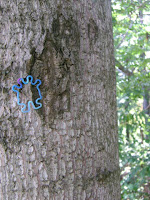 1.Adaptation of an animal This fish has adapted to live in this tank.
1.Adaptation of an animal This fish has adapted to live in this tank. 2.Actin This protein helps me move my cells and contract muscles.
2.Actin This protein helps me move my cells and contract muscles. 3.Water properties-Cohesion These water droplets bind to each other.
3.Water properties-Cohesion These water droplets bind to each other. 4.Eubacteria The algae on the tank.
4.Eubacteria The algae on the tank. 5.ectotherm these animals rely on the heat around them and have very low metabolisms.
5.ectotherm these animals rely on the heat around them and have very low metabolisms.  6.diploid chromosome number such as what my niece has.
6.diploid chromosome number such as what my niece has. 7.woody stem a plant that has been growing for two years or more.
7.woody stem a plant that has been growing for two years or more. 8.Thorn of a plant these are there for the protection of the plant against herbivores.
8.Thorn of a plant these are there for the protection of the plant against herbivores. 9.Tendril of a plant such as this as it creeps up the tree.
9.Tendril of a plant such as this as it creeps up the tree. 10.Radial symmetry is having similar parts regularly arranged around a central axis such as these flowers.
10.Radial symmetry is having similar parts regularly arranged around a central axis such as these flowers. 11.Pollinator such as these bees aid flowers in reproduction.
11.Pollinator such as these bees aid flowers in reproduction.  12.Lepidoptera is a large order of insects including moths and butterflies.
12.Lepidoptera is a large order of insects including moths and butterflies. 13.Keratin is the primary key structural component in hair and nails.
13.Keratin is the primary key structural component in hair and nails. 14.Insect
14.Insect 15.Vascular tissue The primary components are phloem and xylem,and these two help keep this plant survive.
15.Vascular tissue The primary components are phloem and xylem,and these two help keep this plant survive. 16.Gymnosperm cone are seed-bearing plants, whose seeds do not form inside fruits but outside the ovum.
16.Gymnosperm cone are seed-bearing plants, whose seeds do not form inside fruits but outside the ovum. 17.Fleshy fruit such as the apple have a thick fleshy layer and smooth skin.
17.Fleshy fruit such as the apple have a thick fleshy layer and smooth skin. 18.Exoskeleton such as the exoskeleton of this cricket is to support and protect.
18.Exoskeleton such as the exoskeleton of this cricket is to support and protect. 19.Epithelial tissue such as my wrist are known collectively as the epithelium, can filter, absorb, and diffuse various substances, and it is also involved in sensory perception and bodily secretions.
19.Epithelial tissue such as my wrist are known collectively as the epithelium, can filter, absorb, and diffuse various substances, and it is also involved in sensory perception and bodily secretions. 20.Endotherm is an animal that is capable of producing high amounts of energy to maintain a high core temperature.
20.Endotherm is an animal that is capable of producing high amounts of energy to maintain a high core temperature. 21. Deciduous leaf is a leaf that falls off when mature.
21. Deciduous leaf is a leaf that falls off when mature.
22. Conifer leaf

22.Carbohydrate-Fibrous
Fibrous carbohydrates are complex carbohydrates that come mostly from green vegetables.There function is to move starch through the body.
 23.Bryophyte- Seedless land plants that make up the division Byrophta.
23.Bryophyte- Seedless land plants that make up the division Byrophta. 24.Autotroph- an organism that manufactures its own food from inorganic substances, such as carbon dioxide and ammonia.
24.Autotroph- an organism that manufactures its own food from inorganic substances, such as carbon dioxide and ammonia. 25.Arthropod-any invertebrate of the phylum Arthropoda, having jointed limbs, a segmented body, and an exoskeleton made of chitin.
25.Arthropod-any invertebrate of the phylum Arthropoda, having jointed limbs, a segmented body, and an exoskeleton made of chitin. 26.Anther and filament of a stamen-The stamen is the male reproductive part of a flower.There are two parts of the stamen are the filament which is a thin stalk that supports the anther,and the anther which the pollen grains are developed.
26.Anther and filament of a stamen-The stamen is the male reproductive part of a flower.There are two parts of the stamen are the filament which is a thin stalk that supports the anther,and the anther which the pollen grains are developed.
































